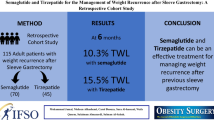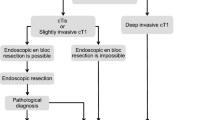Abstract
After colectomy with ileorectal anastomosis (IRA) for treatment of familial adenomatous polyposis (FAP), the rectal mucosa remains, with the risk of malignant change. Locoregional (rectal) sulindac has been applied, with initial higher-dose therapy and subsequent low-dose maintenance therapy to minimise side-effects. The dose-finding study with sulindac suppositories started with a dose of 300 mg sulindac daily per patient over 6 weeks. Depending on proctoscopical evaluation of regression of polyposis, sulindac doses were reduced in predefined steps. Ten of 15 patients developed a complete remission following 42 weeks of treatment, while the rest had partial remission. Responses were recorded 6–24 weeks after beginning sulindac treatment. After 36 weeks, 13/15 patients received 25–50 mg sulindac daily. An increase in the number of partial remissions after 42 weeks of treatment at doses of 100 mg sulindac daily may indicate the first approach to a reduced dose between 100 mg to 25 mg sulindac daily, but may also point to the importance of long-term treatment rather than dose-intense therapy.
Résumé
Après colectomie et anastomose iléo-rectale (AIR) pour le traitement de la polypose adénomateuse familiale (PAF) il demeure un risque de malignisation de la muqueuse rectale. Une application locale (rectale) de Sulindac a été effectuée avec des doses initiales élevées et une poursuite du traitement avec des doses plus faibles afin de diminuer les effets nocifs. L'étude dose-relation avec des suppositoires de Sulindac a commencé avec une dose de 300 mg de Sulindac quotidiens par malade pendant 6 semaines. Selon l'évaluation de la régression des polypes en proctoscopie, les doses de Sulindac étaient réduites de façon prédéfinie. 10 des 15 malades ont développé une rémission complète après 42 semaines de traitement tandis que les autres avaient une rémission partielle. La réponse a été réévaluée 6 à 24 semaines après le début du traitement par Sulindac. Après 36 semaines, 13 des 15 patients avaient reçu 25 à 50 mg quotidiens. L'augmentation du nombre des rémissions partielles après 42 semaines de traitement à la dose de 100 mg de Sulindac quotidiens peut indiquer une première approximation pour des doses réduites entre 100 et 25 mg de Sulindac quotidiens mais peut aussi souligner l'importance du traitement à long terme plutot que de l'intensité des doses thérapeutiques.
Similar content being viewed by others
References
Jagelman DG (1991) Choice of operation in familial adenomatous polyposis. World J Surg 15:47–49
Sarre RG, Jagelman DG, Beck GJ, McGannon E, Fazio VW, Weakley FL, Lavery IC (1987) Colectomy with ileorectal anastomosis for familial adenomatous polyposis: The risk of rectal cancer. Surgery 101:20–26
Scott HW, Weaver FA, Fletcher JR, Sawyers JL, Adinks RB (1986) Is ileoproctostomy a reasonable procedure after total abdominal colectomy? Ann Surg 203:583–587
Jagelman DG (1989) Clinical management of familial adenomatous polyposis. Cancer Surv 8:159–167
Arvanitis ML, Jagelman DG, Fazio VW, Lavery IC, McGannon E (1990) Mortality in patients with familial adenomatous polyposis. Dis Colon Rectum 33:639–642
Duggan DE, Hare LE, Ditzler CA, Lei BW, Kwan KC (1977) The disposition of sulindac. Clin Pharmacol Ther 21:326–335
Waddel WR, Loughry RW (1983) Sulindac for polyposis of the colon. J Surg Oncol 24:83–87
Gonzaga RAF, Lima FR, Carneiro S, Maciel J, Junior MA (1985) Sulindac treatment for familial polyposis coli. Lancet i: 751
Waddell WR, Ganser GF, Cerise EJ, Loughry RW (1989) Sulindac for polyposis of the colon. Am J Surg 157:175–179
Charneau JD, D'Aubigny N, Burtin P, Person B, Boyer J (1990) Micropolypes recteaux après colectomic totale pour polypose familiale. Efficacité du sulindac. Gastroenterol Clin Biol 14:153–157
Friend WG (1990) Sulindac suppression of colorectal polyps in Gardner's syndrome. Am Fam Physician 41:891–894
Labayle D, Fischer D, Vielh P, Drouhin F, Pariente A, Bories C, Duhamel O, Trousset M, Attali P (1991) Sulindac causes regression of rectal polyps in familial adenomatous polyposis. Gastroenterology 101:635–639
Iwana T, Imajo M, Mishima Y (1991) Is sulindac effective for familial adenomatous polyposis? Int J Colorect Dis 6:235
Feinberg SM, Jagelman DG, Sarre RG, McGannon E, Fazio VW, Lavery IC, Weakley FL, Easley KA (1988) Spontaneous resolution of rectal polyps in patients with familial adenomatous polyposis following abdominal colectomy and ileorectal anastomosis. Dis Colon Rectum 31:169–175
Shepherd JA (1971) Familial polyposis of the colon w referrence to regression of rectal polyposis after subtotal colectomy. Br J Surg 58:85–91
Localio SAJ (1962) Spontaneous disappearance of rectal polyps following subtotal colectomy and ileoproctostomy for polyposis of the colon. Am J Surg 103:81–82
Sulindak — en biverkningsöversikt. Leverreaktioner mest utmärkande. Läkartidningen 1987; 84:142, 144
Moorghen M, Ince P, Finney KJ, Sunter JP, Appleton DR, Watson AJ (1988) A protective effect of sulindac against chemically-induced primary colonic tumours in mice. J Pathol 156:341–347
Skinner SA, Penney AG, O'Brien PE (1991) Sulindac inhibits the rate of growth and appearance of colon tumour in the rat. Arch Surg 126:1094–1096
Bennett A, Tacca MD, Stanford IF, Selero T (1977) Prostaglandins from tumours of the large bowel. Br J Cancer 35:881–884
Strong HA, Warner NJ, Renwick AG, George CF (1985) Sulindac metabolism: The importance of an intact colon. Clin Pharmacol Ther 38:387–393
Peterson HI (1988) Tumor angiogenesis inhibition by prostaglandin synthetase inhibitors. Anticancer Res 6:251–254
Haynes WL, Proia AD, Klintworth GK (1989) Effect of inhibitors of arachidonic acic metabolism on corneal neovascularization in the rat. Invest Ophthalmol Visual Sci 30:1588–1593
Bussey HJR, DeCosse JJ, Deschner EE, Eyers AA, Lesser ML, Morson BC, Ritchie SM, Thomson JPS, Wadsworth J (1982) A randomized trial of ascorbic acid in polyposis coli. Cancer 50:1434–1439
Itoh H, Iida M, Mibu R, Terasaka R, Ohsato K (1989) Local chemotherapy for rectal polyposis: Intraluminal administration of 5-Fluorouracil for postoperative control of adenomas in the retained rectum in familial polyposis. J Clin Gastroenterol 11:645–649
Ligumsky M, Sestieri M, Karmeli F, Zimmerman J, Okon E, Rachmielewitz D (1990) Rectal administration of nonsteroidal antiinflammatory drug: Effect on rat ulcerogenicity and prostaglandin E2 synthesis. Gastroenterology 98:1245–1249
Madden MV, Neale KF, Nicholls RJ, Landgrebe JC, Chapman PD, Bussey HJR, Thomson JPS (1991) Comparison of morbidity and function after colectomy with ileorectal anastomosis or restorative proctocolectomy for familial adenomatous polyposis. Br J Surg 78:789–792
Bülow S (1984) The risk of developing rectal cancer after colectomy and ileorectal anastomosis in Danish patients with polyposis coli. Dis Colon Rectum 27:726–729
Heimann TM, Gelernt I, Salky B, Bauer J, Greenstein A, Beck AR (1987) Familial adenomatous polyposis: Results of mucosal proctectomy with ileoanal anastomosis. Dis Colon Rectum 30:424–427
Schmidt E (1987) Kontinenzerhaltung bei Adenomatosis coli and Colitis ulcerosa. Langenbecks Arch Chir 372:425–428
Dozois R (1986) Restorative proctocolectomy and ileal reservoir. Mayo Clin Proc 61:283–286
Sugerman HJ, Newscome HH, Decosta G, Zfass AM (1991) Stapled ileoanal anastomosis for ulcerative colitis and familial polyposis without temporary diverting ileostomy. Ann Surg 213:606–617
Stelzner M, Fonkalsrud EW (1989) The endorectal ileal pullthrough procedure in patients with ulcerative colitis and familial adenomatous polyposis with carcinoma. Surg Gynecol Obstet 169:187–194
Watne AL, Carrier JM, Durham JP, Hrabovsky EE, Chang W (1983) The occurrence of carcinoma of the rectum following ileoproctostomy for familial polyposis. Ann Surg 197:550–553
Moertel CG, Hill JR, Adson MA (1970) Surgical management of multiple polyposis. Arch Surg 100:521–526
Author information
Authors and Affiliations
Additional information
The study was supported by a grant of ribosepharm GmbH, W-5657 Haan 1, Germany
Rights and permissions
About this article
Cite this article
Winde, G., Gumbinger, H.G., Osswald, H. et al. The NSAID sulindac reverses rectal adenomas in colectomized patients with familial adenomatous polyposis: clinical results of a dose-finding study on rectal sulindac administration. Int J Colorect Dis 8, 13–17 (1993). https://doi.org/10.1007/BF00341270
Accepted:
Issue Date:
DOI: https://doi.org/10.1007/BF00341270




